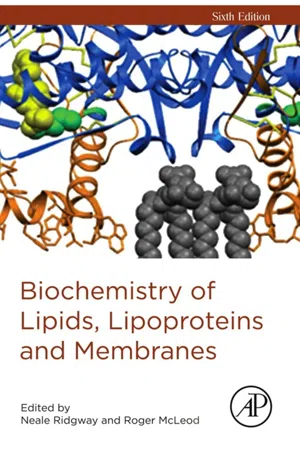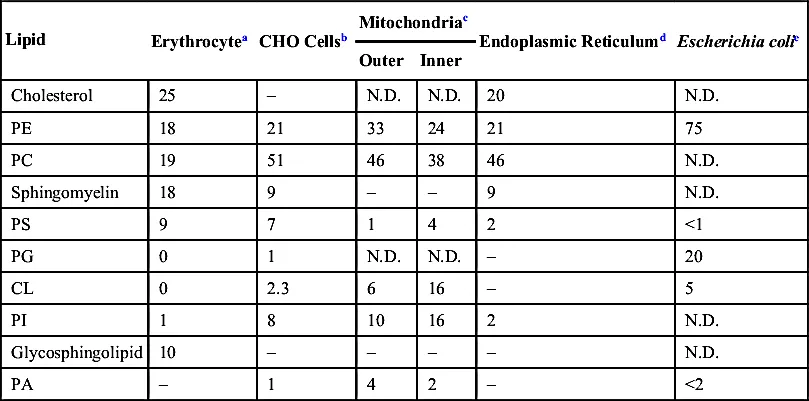
Biochemistry of Lipids, Lipoproteins and Membranes
Neale Ridgway,Roger McLeod
- 612 Seiten
- English
- ePUB (handyfreundlich)
- Über iOS und Android verfügbar
Biochemistry of Lipids, Lipoproteins and Membranes
Neale Ridgway,Roger McLeod
Über dieses Buch
Biochemistry of Lipids: Lipoproteins and Membranes, Volume Six, contains concise chapters that cover a wide spectrum of topics in the field of lipid biochemistry and cell biology. It provides an important bridge between broad-based biochemistry textbooks and more technical research publications, offering cohesive, foundational information.
It is a valuable tool for advanced graduate students and researchers who are interested in exploring lipid biology in more detail, and includes overviews of lipid biology in both prokaryotes and eukaryotes, while also providing fundamental background on the subsequent descriptions of fatty acid synthesis, desaturation and elongation, and the pathways that lead the synthesis of complex phospholipids, sphingolipids, and their structural variants. Also covered are sections on how bioactive lipids are involved in cell signaling with an emphasis on disease implications and pathological consequences.
- Serves as a general reference book for scientists studying lipids, lipoproteins and membranes and as an advanced and up-to-date textbook for teachers and students who are familiar with the basic concepts of lipid biochemistry
- References from current literature will be included in each chapter to facilitate more in-depth study
- Key concepts are supported by figures and models to improve reader understanding
- Chapters provide historical perspective and current analysis of each topic
Häufig gestellte Fragen
Information
Functional Roles of Lipids in Membranes
Abstract
Keywords
Charge balance rule; Hydrophobic effect; Lipid diversity; Lipid–protein interactions; Membrane structure1. Introduction and Overview

| Lipid | Erythrocytea | CHO Cellsb | Mitochondriac | Endoplasmic Reticulumd | Escherichia colie | |
| Outer | Inner | |||||
| Cholesterol | 25 | – | N.D. | N.D. | 20 | N.D. |
| PE | 18 | 21 | 33 | 24 | 21 | 75 |
| PC | 19 | 51 | 46 | 38 | 46 | N.D. |
| Sphingomyelin | 18 | 9 | – | – | 9 | N.D. |
| PS | 9 | 7 | 1 | 4 | 2 | <1 |
| PG | 0 | 1 | N.D. | N.D. | – | 20 |
| CL | 0 | 2.3 | 6 | 16 | – | 5 |
| PI | 1 | 8 | 10 | 16 | 2 | N.D. |
| Glycosphingolipid | 10 | – | – | – | – | N.D. |
| PA | – | 1 | 4 | 2 | – | <2 |
2. Diversity in Lipid Structure
2.1. Glycerolipids
Inhaltsverzeichnis
- Cover image
- Title page
- Table of Contents
- Copyright
- Contributors
- Preface
- Chapter 1. Functional Roles of Lipids in Membranes
- Chapter 2. Approaches to Lipid Analysis
- Chapter 3. Fatty Acid and Phospholipid Biosynthesis in Prokaryotes
- Chapter 4. Lipid Metabolism in Plants
- Chapter 5. Fatty Acid Handling in Mammalian Cells
- Chapter 6. Fatty Acid Desaturation and Elongation in Mammals
- Chapter 7. Phospholipid Synthesis in Mammalian Cells
- Chapter 8. Phospholipid Catabolism
- Chapter 9. The Eicosanoids: Cyclooxygenase, Lipoxygenase and Epoxygenase Pathways
- Chapter 10. Sphingolipids
- Chapter 11. Cholesterol Synthesis
- Chapter 12. Bile Acid Metabolism
- Chapter 13. Lipid Modification of Proteins
- Chapter 14. Intramembrane and Intermembrane Lipid Transport
- Chapter 15. High-Density Lipoproteins: Metabolism and Protective Roles Against Atherosclerosis
- Chapter 16. Assembly and Secretion of Triglyceride-Rich Lipoproteins
- Chapter 17. Lipoprotein Receptors
- Chapter 18. Atherosclerosis
- Chapter 19. Diabetic Dyslipidaemia
- Index
